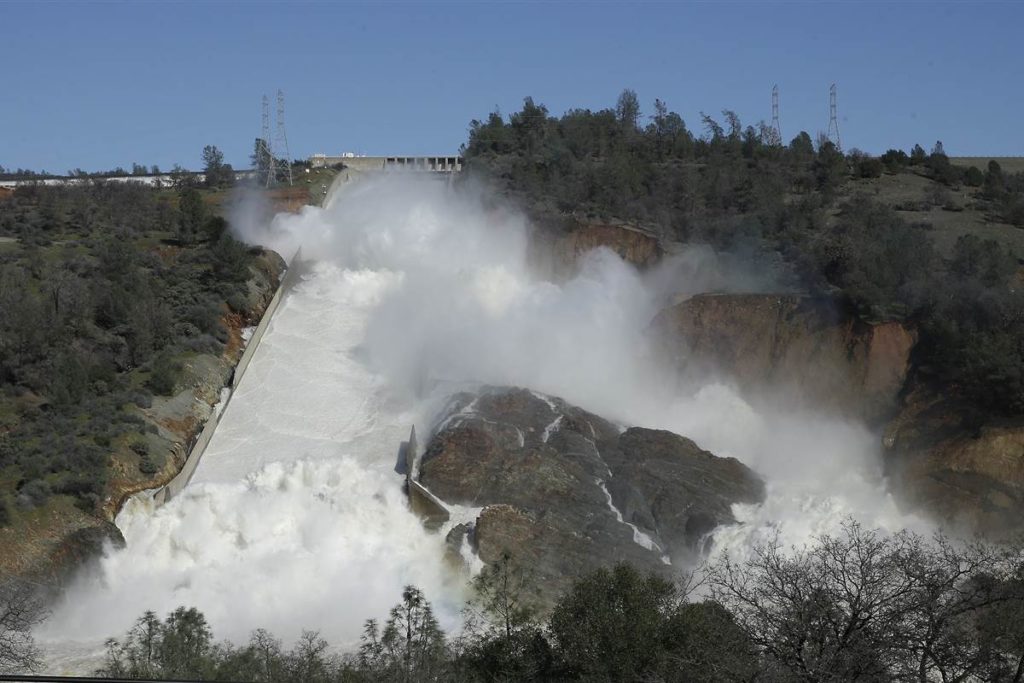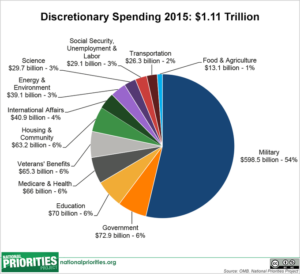Youtopia is dedicated to the proposition that our…
023 Oroville Dam and America’s Infrastructure, Collateral Damage of Massive Military Spending

The warnings went unheeded, California’s Oroville Dam threatens thousands flee
There’s a finite amount of money available, and an infinite amount of infrastructure projects that desperately need funding. As we now know, the under-engineered Oroville Dam spillway reached near-catastrophe this last weekend as a deluge threatened hundreds of thousands of downstream residents. The emergency spillway of the 770 foot high dam, the tallest in the country, was already eroded and threatens to fail entirely because it was never brought up to standards even though the warnings were loud and clear.
By Kristine Guerra February 14, Washington Post
In 2005, three environmental groups warned state and federal officials about what they believed was a problem with the Oroville Dam’s emergency spillway — the same one that was at risk of collapsing this week, after storms caused the adjacent reservoir to swell.
The groups’ concern, which seems to have fallen on deaf ears at the time, was that the emergency spillway is not really a spillway. Rather, it’s a 1,700-foot-long concrete weir that empties into a dirt hillside.
That means in the event of severe flooding, water would erode that hillside and flood nearby communities in Northern California’s gold country, the groups said then.
That nearly happened Sunday, when a hole in the emergency spillway threatened catastrophic floods and prompted officials to evacuate nearly 200,000 residents, who remain uncertain when they’ll be allowed to return to their homes — especially with three storms lined up to drench Northern California over the next week.
‘I’m terrified I’m not going to have a home to come home to,’ says an unnamed source in the WaPo article.
So is underfunding of our infrastructure a form of domestic terrorism? Doesn’t Congress Critters have to swear an oath promising to defend the Constitution, meaning the people, from ALL threats, foreign and domestic?
In October 2005, as the Oroville Dam was going through a re-licensing process, the three groups filed a motion urging a federal regulatory agency to require state officials to armor the emergency spillway with concrete so that in the event of extreme rain and flooding, water would not freely cascade down and erode the hillside. The upgrade would have cost millions of dollars and no one wanted to foot the bill, said Ronald Stork, senior policy advocate for Friends of the River, one of the groups that filed the motion.
As of this writing, helicopters are slinging in huge bags of boulders in an attempt to arrest the erosion, and it appears these efforts and diminished rainfall are helping reduce the immediate threat, but more rain is in the forecast so the spillway has to be brought up to standards sooner or later.
The Oroville Dam near-disaster is helping stimulate discussion on infrastructure spending, some call spending on infrastructure, stimulus money. That would be Mitch McConnell. When the levee breaks is much more than a famous Led Zeppelin song, it was the swan song of the poorest boroughs of New Orleans where more than 1,800 people lost their lives after the devastation of Hurricane Katrina in August, 2005.
By Igor Bobic, HuffPost February 13, 2017
Failure to invest in infrastructure comes at a heavy cost. Collapses in the New Orleans levee system led to mass flooding, billions of dollars in property damage and hundreds of deaths in the wake of Hurricane Katrina in 2005.
One of Trump’s biggest promises for his first 100 days was to deliver a $1 trillion infrastructure plan to Congress. But Senate Majority Leader Mitch McConnell (R-Ky.) poured cold water over the idea of a large spending package in December, telling reporters he hoped to avoid “a trillion-dollar stimulus.” And with other items on Trump’s agenda ― including the repeal of the Affordable Care Act and an overhaul of the nation’s tax system ― seemingly stalled on Capitol Hill, a major infrastructure bill could take years to land on the president’s desk. (And more from Bobic, Dec 12, 2016).
A statement on his transition website now says the incoming administration “seeks to invest $550 billion to ensure we can export our goods and move our people faster and safer.” The president-elect doubled down on his plans after the election, telling Time magazine that “sometimes you have to prime the pump” ― evidently referring to the government’s role in jump-starting economic recovery.
Republicans have for years resisted the idea of government spending as a means to spur economic growth, blocking several of the Obama administration’s proposals to create jobs and fix the country’s infrastructure. McConnell and his House counterpart, Speaker Paul Ryan (R-Wis.), led the charge against such initiatives. A big spending plan likely wouldn’t find much support among deficit-averse conservatives on the Hill next year, either.
Incoming Senate Minority Leader Chuck Schumer (D-N.Y.) has said he welcomes the opportunity to work with Trump to pass the $1 trillion infrastructure bill, possibly using corporate tax reform as a means to pay for the measure.
Good for Trump on that one, but we need results. Businessmen don’t want excuses, they want results. And let’s not forget Trump’s other promise was to vastly increase military spending, but we’re getting to that.
We also cannot forget Detroit’s water crisis, an issue that had the rest of the world looking at us as if we were becoming a third world banana republic led by a tyrannical military dictatorship—I said, we’re getting to that.
By Heather Smith Grist Magazine, July 17, 2014
This May, the Detroit Water and Sewerage District (DWSD) sent out 46,000 shutoff notices to customers who were behind in their water bills. It was the latest calamity to befall a city that had seen its water rates rise 119 percent in the last decade.
Water pipes in Flint Michigan gives residents all the essential minerals, including lead
As a city that has lost nearly two-thirds of its population in the last 60 years, Detroit has a lot of water infrastructure to maintain, and not much money to maintain it.
Since the shutoffs began (about 17,000 households and small businesses have lost service to date), residents have fought back hard. They’ve blocked trucks that are being sent out to shut off water accounts. They’ve called out DWSD for focusing on shutting off water to private homes that don’t even owe that much, while ignoring golf courses that owe amounts in the hundreds of thousands. (DWSD responded that it had focused on residential customers because shutting off water to a large-scale user was more technically complicated than most of its employees can handle.) They’ve accused DWSD of dropping low-income customers as a way of making the system more appealing to potential buyers.
The well-known international corporation Nestle’ adds insult to Detroit’s injury. Empathy is seldom a byproduct of corporate objectives as evidenced in this Democracy Now video and excerpts, by Amy Goodman on February 17, 2016.
As Flint residents are forced to drink, cook with and even bathe in bottled water, while still paying some of the highest water bills in the country for their poisoned water, we turn to a little-known story about the bottled water industry in Michigan. In 2001 and 2002, the Michigan Department of Environmental Quality issued permits to Nestlé, the largest water bottling company in the world, to pump up to 400 gallons of water per minute from aquifers that feed Lake Michigan.
(And later in the interview).
One of the most surprising things about this story is that, in Mecosta County, Nestlé is not required to pay anything to extract the water, besides a small permitting fee to the state and the cost of leases to a private landowner. In fact, the company received $13 million in tax breaks from the state to locate the plant in Michigan. The spokesperson for Nestlé in Michigan is Deborah Muchmore. She’s the wife of Dennis Muchmore—Governor Rick Snyder’s chief of staff, who just retired and registered to be a lobbyist.
This sinister plot was submitted to Hollywood producers, but they rejected it as too far-fetched, nobody would believe it. (Ok, I made that one up).
So far we’ve only looked at a small portion of the ongoing collapse of infrastructure in America. Remember back in August 1, 2007 when the I-35W Mississippi River Bridge collapsed in Minneapolis killing 13 and injuring 145? This was an eight-lane, steel truss arch bridge on Interstate I-35W which carried 140,000 vehicles daily.

Minneapolis Bridge Collapse
Or closer to me, the collapse of another bridge on another Interstate, the I-5 bridge over the Skagit River, about an hour’s drive north of Seattle. This bridge and I have two things in common, we were both born in 1955, and neither of us could withstand a glancing blow from a tractor-trailer, which was hauling an oversized load and hit one of the bridge’s overhead tresses. This happened on May 23, 2013, luckily nobody died, three were injured and traffic was fubared in both directions of I-5 for some time.

Skagit River Bridge Collapse, Washington State
It’s difficult to find updated stats on the plight of our infrastructure, the most recent thorough study was produced by The American Society of Civil Engineers, (ASCE). From a CBS report of announced Tuesday that the U.S. earned a grade of D+ in its 2013 Report Card for America’s Infrastructure.
The latest report card, which is issued every four years, is actually a slight improvement on the “D” grade issued in 2009. But it found that the nation had significant work to do to shore up its infrastructure. ASCE estimates that the U.S. needs to spend $3.6 trillion on infrastructure by 2020 — $1.6 trillion more than current funding levels allow.
The highest grade within the report was a B- for solid waste systems. Americans recycled 34 percent of their 250 million tons of trash in 2010, more than double the rate of 14.5 percent in 1980.
The lowest grade, a D-, went to levees and inland waterways. “The U.S. does not have a levee safety program,” according to ASCE. “Public safety remains at risk as roughly $100 billion is needed to repair the nation’s estimated 100,000 miles of levees that increasingly are protecting developed communities.” The report said that many portions of inland waterways have not been updated since the 1950s despite the fact that inland waterways and rivers carry the equivalent of 51 million truck trips per year.
Many areas received D grades. They include roads, due to a 42 percent congestion rate on highways; dams, which have an average age of 52 years old; drinking water, because “frequent water main breaks, pipes and mains that are frequently more than 100 years old are reaching the end of their life cycle and require significant investment”; hazardous waste systems, because Superfund and brownfield site cleanups face a “severe” budgetary shortfall; transit, which faces challenges tied to increasing ridership and declining funding; schools, which the report says need $270 billion or more in funding to modernize public school buildings; and aviation, with the FAA estimating that airport congestion and delays cost nearly $22 billion in 2012.


Congested Roads Reduce Productivity and Increase Stress
Spending our hard earned tax dollars on infrastructure nets many benefits, improved water quality, traffic flow, safety, productivity, it would lessen stressful commutes and return some precious time for ourselves and our families. So why are Americans among the most productive workers in the world, yet we can’t find money for infrastructure?
https://www.youtube.com/watch?v=6R6ofqAW8XM
Well that explains some of it, but that was way back at the beginning of the Cheney/Bush Administration and Pentagon Comptroller Dov Zakheim continued on in that same role until 2004, and, allegedly lost or “cannot account” for another one-trillion dollars of missing tax payer money. The math so far is around $3.3 TRILLION deducted from infrastructure spending and “lost” in the DOD budget–and you remember the old saying: Losers weepers, finders keepers, as some of the very richest neighborhoods in the world just happen to be home to military contractors in Virginia and D.C., perhaps this is the “lost track of” Rumsfeld talks about. It would be enlightening if the mainstream media, which constantly pays tribute to the “sacrifice” of the troops, which is real, would also contrast that with the “windfalls” enjoyed by the weapons manufacturers and their Generals-turned-lobbyists-turned-consultants. How about sending a television crew to these neighborhoods that are more exclusive and wealthy than even Beverly Hills? Show their “sacrifice.”
There are many recent examples of the taxpayers being milked as patriotic suckers. This from that conspiracy magazine called Time.
The Navy’s new Littoral Combat Ship (LCS) is not only staggeringly overpriced and chronically unreliable but — even if it were to work perfectly — cannot match the combat power of similar sized foreign warships costing only a fraction as much. (And later in the bullet points).
— Since neither design had yet proven either its usefulness or functionality it seems that the Navy’s object was to make the LCS program “too big to fail” as soon as possible.
— It may be working: the 55-ship fleet is slated to cost more than $40 billion, giving each vessel a price tag north of $700 million, roughly double the original estimated cost.–John Sayen Oct. 05, 2012
USS Littoral Class Ships, twice as expensive as their British Counterparts
And from Business Insider, concerning Britain’s very similar ships.
“The T26 GCS will be a multi-mission warship designed for joint and multinational operations … including complex combat operations, maritime security operations such as counter piracy, as well as humanitarian and disaster relief work around the world.”
The new ship is outfitted with missile silos for cruise missiles, hangars for drones or helicopters, and extra space for submersibles and other Naval equipment.
The project shows the stark contrast from the uber-expensive, problem plagued U.S. Littoral Combat Ship. With a price tag of $350, the U.S. LCS is a virtual twin to British GCS, at twice the price.
The Littoral ships, are literally tiny in heft and dollars compared to our new “Super Carrier,” The USS Gerald Ford, so far coming in at $13 billion, says The Verge.
What’s more, the USS Gerald Ford — identified by its hull number, CVN 78, and known conversationally as “the Ford” — is also outfitted with electromagnetic catapults designed to shoot fighter jets into the sky (these had previously needed pneumatic systems; Ford-class carriers offered all-new technology), and the most advanced radar system ever deployed by the US military.
But all this heft and tech prowess isn’t cheap. At the moment, it’s estimated that the Ford will cost taxpayers at least $13 billion — an amount that, despite years of planning and calculation, has risen at least $2.3 billion since the ship’s construction costs were approved at a $10.5 billion budget in 2008. And it might rise higher still. While Newport News Shipbuilding (NNS), the company contracted to construct the Ford, is confident it has built an aircraft carrier that will last well into the 21st century, high-profile critics such as Senator John McCain are asking whether the Ford is worth the cost and the monumental effort it will take to bring it to life.
The US Navy, which defends America from the vast sea of enemies the CIA creates, plies the vast seas of taxpayer monies. The DOD has outdone themselves with the Zumwalt-class destroyers.
Stealth mode, engines off, get tug boat; breakdown in Panama Canal
WASHINGTON — With sharp angles and sleek surfaces that evoke Hollywood science fiction, the Zumwalt-class guided-missile destroyer is the weirdest-looking warship produced in Maine since the Navy launched a low-slung oddity called the USS Katahdin 125 years ago. Widely mocked, the Katahdin ended up being used for target practice.
The 600-foot Zumwalt — picture an Aztec pyramid welded atop a machete blade — is an infinitely more elaborate and costly ship, a futuristic showcase crammed with electronic innovations. But it, too, appears destined to fall well short of its promise.
After two decades on the drawing board and a tortured recent history, the $22 billion Zumwalt program is seen by numerous critics as a prime example of Pentagon budget bloat, delays, and misplaced priorities.
The Navy doomed the ship to sideline status when it slashed its order to just three of the vessels, from an original plan for 32. It disclosed in 2008 that the warship would be vulnerable to enemy missiles and submarines. And it has publicly questioned the destroyer’s mission and usefulness–yet plans to build three of the pricey ships — at $4.3 billion each — went ahead.
The priciest real estate in one of the region’s wealthiest enclaves can be a dangerous place to be a tree. A few years after Daniel Snyder, the owner of the Washington Redskins, was penalized for cutting down 130 trees to improve the view from his Potomac estate, one of his high-powered neighbors is coming under fire for clear-cutting nearly an acre of protected land that overlooks the C&O Canal and the Potomac River.Late last month, Montgomery County issued a $1,000 fine to Robert J. Stevens, the chief executive of Lockheed Martin. Federal park police have opened a criminal investigation into whether the tree-cutting in the Merry-Go-Round Farm community also violated a federal easement designed to protect the canal, the river and scenic vistas. And environmentalists said they were enraged that another large swath of trees has been cut down.“This is outrageous,” said Dolores Milmoe of the Audubon Naturalist Society in Chevy Chase. “Once again, people of great wealth feel entitled that they can just end run the permitting process or not get permits.” Lockheed CEO Robert Stevens demonstrates how bloated military budgets strangle infrastructure spending
–Stevens, 61, whose 2011 compensation package totaled $25.3 million, paid the county’s fine and, through his attorney, said he regretted not getting approval and will work to restore the land.–
The USAF originally envisioned ordering 750 ATFs (F-22 Raptors) at a cost of $26.2 billion, with production beginning in 1994. The 1990 Major Aircraft Review led by Secretary of Defense Dick Cheney reduced this to 648 aircraft beginning in 1996. By 1997, funding instability had further cut the total to 339, which was again reduced to 277 F-22s by 2003. In 2004, the Department of Defense (DoD) further reduced this to 183 operational aircraft, despite the USAF’s preference for 381. In 2006, a multi-year procurement plan was implemented to save $15 billion but raise each aircraft’s cost. That year the program’s total cost was projected to be $62 billion for 183 F-22s distributed to seven combat squadrons. In 2007, Lockheed Martin received a $7.3 billion contract to increase the order to 183 production F-22s and extend manufacturing through 2011.
In April 2006, the Government Accountability Office (GAO) assessed the F-22’s cost to be $361 million per aircraft, with $28 billion invested in development and testing; the Unit Procurement Cost was estimated at $178 million in 2006, based on a production run of 181 aircraft. It was estimated by the end of production, $34 billion will have been spent on procurement, resulting in a total program cost of $62 billion, around $339 million per aircraft. The incremental cost for an additional F-22 was estimated at about $138 million in 2009. The GAO stated the estimated cost was $412 million per aircraft in 2012.
Did you follow the ever rising costs and ever diminishing numbers of planes? This is what happens when private contractors know there will be no consequences for bilking the taxpayer–infrastructure be damned. Not only do these weapons systems fail to deliver the best bang-for-the-buck payload, but the military is crying foul because existing planes and ships, and troop support is lacking funds. Say what?
Congress’ inability to pass a budget is hurting the fleet, leaders say
From Defense News, February 6, 2017: WASHINGTON — The U.S. Navy’s F/A-18 Hornet and Super Hornet strike fighters are the tip of the spear, embodying most of the fierce striking power of the aircraft carrier strike group. But nearly two-thirds of the fleet’s strike fighters can’t fly — grounded because they’re either undergoing maintenance or simply waiting for parts or their turn in line on the aviation depot backlog.
Overall, more than half the Navy’s aircraft are grounded, most because there isn’t enough money to fix them. Additionally, there isn’t enough money to fix the fleet’s ships, and the backlog of ships needing work continues to grow. Overhauls — “availabilities” in Navy parlance — are being canceled or deferred, and when ships do come in they need longer to refit. Every carrier overall for at least three years has run long, and some submarines are out of service for prolonged periods, as much as four years or more. One submarine, the Boise, has lost its diving certification and can’t operate pending shipyard work.
Leaders claim that if more money doesn’t become available, five more submarines will be in the same state by the end of this year. The Navy can’t get money to move around service members and their families to change assignments, and about $440 million is needed to pay sailors. And the service claims 15 percent of its shore facilities are in failed condition — awaiting repair, replacement or demolition.
And you may recall during the republican primaries Jeb Bush decried the pitiful state of America’s long range bomber fleet, reminding us the B-52 Stratofortress has been serving the objectives of the NWO since the 1950s, and that’s just terrible. What Jeb and company forget to mention is the military, i.e., the taxpayers, did upgrade our bomber fleets twice, the B-1 and B-2 stealth bombers were supposed to be their replacement. But once again, the military brass and the contractors preferred the ultra complex, stealth planes that do not have the range or capacity of the slower, semi-trucks of the skys, the venerable B-52.

McCain “Bomb bomb bomb, bomb bomb Iran”
That’s not our fault military brass, we work hard, give you more than all the money you want, and you military industrial complex folks piss it away on gizmos and mansions and yachts. We need infrastructure and shoring up social safety net. We don’t need and can’t afford any more military spending nor any more bases. And not only do we spend multiple billions on our own military, Obama recently gifted Israel a $38 billion military aid package, on top of the annual $ 6 billion tribute to AIPAC’S father land, and Trump promises even more military support.
If the military generals want to upgrade the defense areas deemed lacking, find that missing $3.3-plus trillion and quit overcharging and under producing for the weapons systems promised, or you folks will be going to war with the US taxpayers.

Each flag is US military base surrounding Iran.

These two charts clearly show how the American tax payers have been stingy in funding the world’s police force, that, by the way, spends an inordinate amount of time and resources protecting oil shipping lanes and softening up places like Iraq for oil production. Yes folks, our oil companies are in Iraq.


Lee is an author who lives with his wife and near his children and grandchildren in the Pacific Northwest, draws substance from a rather unique chapter in his lifestyle, raising a family in a remote wilderness valley in north central British Columbia. (lee@youtopia.guru) Find Out More >>

















Leave a Comment